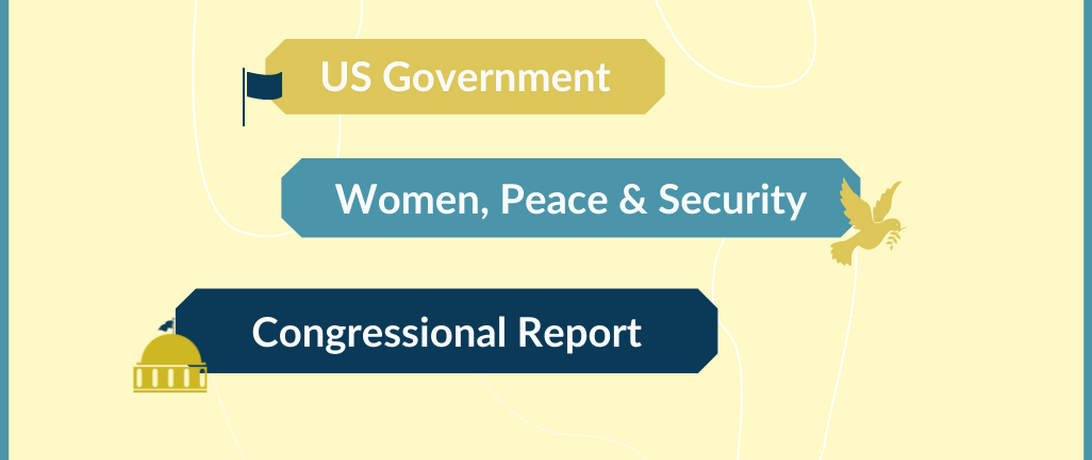
On June 20, 2021, the Biden Administration released its inaugural report on the ongoing implementation of WPS within the administration.
On June 20, 2021, the Biden Administration released the USG Women, Peace and Security Congressional Report on the ongoing implementation of Women, Peace and Security (WPS) within the administration as required by the Women, Peace and Security Act of 2017 (P.L. 115-68). The inaugural report is a critical first step toward ongoing monitoring, evaluation and learning (MEL) around WPS implementation.
However, it also demonstrates the many ways in which the U.S. Government must catch up to civil society’s understanding of this crucial agenda. There are individual areas for improvement within each agency, as well as general weak spots across all four implementing agencies (Department of State, U.S. Agency for International Development, Department of Homeland Security, and Department of Defense).
First, the Department of State’s report includes mention of civil society consultations, but lacks details on the content of these meetings, and the outcomes of these meetings. Additionally, and crucially, State explicitly excludes details of its WPS efforts related to current events, specifically Afghanistan. Keeping in mind that Afghanistan is the largest diplomatic and human rights crisis the U.S. is currently facing, it is imperative that the State Department engage with it through the WPS lens.
Secondly, the U.S. Agency for International Development (USAID) must be more transparent with its funding. The Agency must provide details on indicated funding figures in order to avoid double-counting, thus inflating those numbers. Additionally, USAID should clarify why they are prioritizing consultations with faith-based organizations. Given that the majority of organized religions are largely patriarchal, it is unclear why these organizations are the best to consult on gender-related issues.
The Department of Homeland Security (DHS) seems to misunderstand the relevance of Women, Peace and Security to its mission. Repeatedly throughout the report, the DHS states that it will only play a supporting role in the implementation of WPS because it is exclusively a foreign policy agenda. The misconception of the WPS Act as exclusively international is not siloed to the DHS, so this provides an opportunity for expanding the general U.S. definition of the WPS agenda to include a domestic focus. The DHS should establish regular consultations with civil society in order to improve its implementation of the WPS Act, and the WPS agenda more broadly.
Finally, the Department of Defense’s (DoD) report was the strongest of all the agencies. However, because of their emphasis on training, it would be useful for the DoD to provide details on the sources and references behind the WPS training, as well as who is developing and providing the training.
Beyond these agency-specific recommendations, there are certain areas of opportunity across all implementing agencies. First of all, the agencies need to move away from an emphasis on women and toward a focus on gender. Each agency emphasizes their training of women on WPS-related topics, but no agency discusses the training of men on these issues. It is just as important to train men to be gender champions.
Requiring gender analysis in all funding proposals and programs for every bureau and independent office would also ensure successful and comprehensive implementation of WPS in both domestic and foreign policies. This would also require clarification on the ways in which WPS is included with parallel policies, including the National Security Strategy, the Global Fragility Strategy, and genocide and atrocities prevention strategies.
Additionally, more focus must be placed on prevention and addressing systemic, underlying causes of gender inequality. There is no mention of prevention efforts included in any of the agency narratives throughout the report. In order to integrate prevention into WPS efforts, agencies must engage with women as agents of change, and not simply as victims.
Furthermore, the need for prevention strategies also demonstrates the need to integrate WPS principles into general agency policy-making. While the report focuses on training and participation of women, there is no mention of how WPS principles are implemented in the general design of U.S. policies, who is designing those policies, how the policies are implemented, or how the gendered impacts of the policies are captured.
Going forward, it will be critical for future reports to include several metrics beyond simply the number of women being trained, and guidelines for how implementation will be evaluated. Future reports should cover qualitative data including the impact of WPS policies and the content of civil society consultation, as well as quantitative data including the number of gender advisors in each agency and projected timelines. The inclusion of this reporting structure will greatly advance the implementation of WPS across the U.S. Government.
Article Details
Published
Topic
Program
Content Type
Opinion & Insights